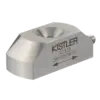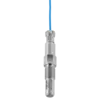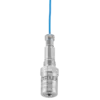Strain sensors

Piezoelelectric strain sensors from Kistler can be used for high-resolution measurements of the strains occurring on a structure. To achieve this, the sensor is mounted in a suitable position. If an indirect force measurement is required, the sensor is calibrated. The relevant factors here are the geometry of the structure, the material's modulus of elasticity and the mechanical stress. Surface strain sensors are attached to the structure with the mounting screw. The structure's strain is transmitted to the measuring element through static friction. Strain measuring pins need a cylindrical mounting bore in which the strain sensor is then inserted and preloaded. Kistler offers piezoelectric strain measurement sensors with axial and radial alignment to the axis of the bore hole.
Learn more about strain sensors by downloading the PDF catalogue.







